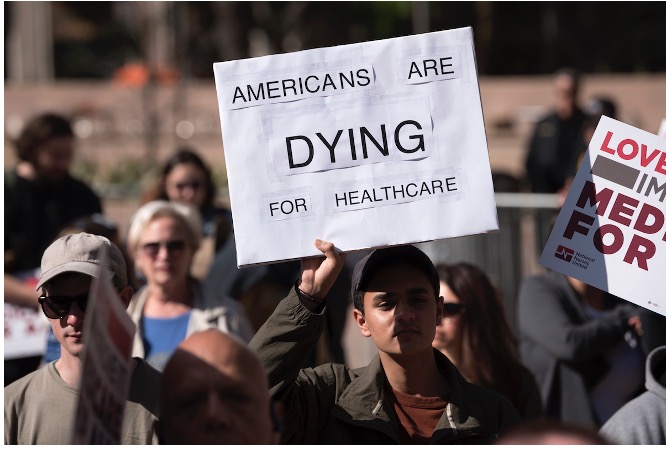Comments
ACCORDING TO LIZ - What does our healthcare system say about our values?
Yes, the United States spends a lot of money on healthcare. Yes, the United States is on the cutting edge of medical services available... to those who can pay.
But the United States spends $4 trillion, 20% of its GDP, or over $12,530 for each man, woman and child, all 330 million of us, on healthcare.
That’s a lot of moolah.
And what do we get for this $4 trillion?
Not much, if results are the metric used to evaluate success. In fact, the American healthcare system is a catastrophic failure by most measurements.
That over a million Americans died during the pandemic, significantly more than in any other developed country, demonstrated the abysmal failure of this country’s public health system.
Life expectancy for Americans dropped as much in that initial year of Covid as it did in 1943, the deadliest year of the Second World War. Of course, most other countries suffered losses but none so dramatic. And the following year their life expectancy numbers bounced back while in the U.S. they continued to fall.
Lack of adequate medical coverage contributes to over sixty thousand unnecessary American deaths every year.
By not taking their prescribed medication because it’s just too damned expensive, many Americans get sicker and end up in emergency rooms costing the system far more than if the drugs were provided in the first place.
Half of all personal bankruptcies in America, 500,000 each and every year, are connected to unpaid medical bills.
And in 2021, over a hundred thousand Americans died from drug overdoses while the three largest pharmaceutical companies increased their profits by over 90%.
The one metric that is the shining exception to these negative numbers are the results for healthcare insurance companies’ primary goal – to make themselves and their shareholders very rich. The mission for these insurers is not health care but to make a profit from health-related services (and denials)... and they are very successful in this narrow quest.
For those sixty thousand unnecessary American deaths every year, the American healthcare industry made $60 billion in profits.
Top CEOs of health insurance corporations make around $20 million in salary a year. And that’s before bonus-time.
As of May 2021, the median annual wage for emergency medical technicians was $35,470, while that for paramedics was $46,770. These are the men and women who work long stressful hours under sometimes dangerous conditions to save people’s lives.
Golden parachutes for top corporate honchos who are terminated if companies are taken over and they are replaced, contracts often set up to avoid hostile takeovers but are also symbols of egregious greed, can run into the millions. A year ago, Moderna’s board of directors approved one for its current CEO of $926 million while two other top executives will have to make do with $165.9 million and $194.3 million respectively. Dollars, that is.
Who pays? We all do. In inflated prices, in lack of services, in seeing the homeless multiply on our streets, and in experiencing the derision of the rest of the developed world.
Bernie Sanders invited Dr. Danielle Martin, a health policy professor and vice-president of medical affairs and health system solutions at Women’s College Hospital in Toronto to testify at a 2014 Senate committee hearing on Canada’s single-payer system.
Dr. Martin cited research showing better outcomes in Canada at a far lower cost than in the U.S.
When asked if it was true Canadians were dying because of health rationing, based on a 2009 Harvard study she replied on point: “I know that there are 45,000 in America who die waiting because they don’t have insurance at all.”
As to the much publicized waiting lists, she responded that they were indeed a problem, especially for elective procedures. But for Americans without insurance, the waiting list could be forever.
Dr. Martin also pointed out that she waited thirty minutes in line to enter the building but there was another entrance with no line, illustrating that it was not the quantity of services but the allocation for the most effective use of choices.
More recently, to counter the mendacity and lack of news coverage, Bernie took a busload of seniors from Detroit five miles over the Ambassador Bridge to a Windsor, Ontario pharmacy to demonstrate that, as Americans in the U.S., they paid ten times what Canadians pay for the exact same drugs.
Should we be focusing on wellness and keeping people healthy? Experience shows that wellness-focused healthcare, targeting early treatment and preventable injuries, has significantly better outcomes at a fraction of the cost.
Primary care in emergency rooms costs ten times what it would cost from a family doctor or in a healthcare center.
But that would reduce the most profitable procedures in the U.S. that benefit insurance company shareholders and executives.
Americans are also suffering from a systemic failure. People involved in the healthcare industry don’t take time because time costs money and reduces profit. Many problems stem from misunderstandings and ignorance due to the failure of both medical and insurance personnel to adequately explain changes to people.
And from service providers not understanding that their job cannot end with a doctor giving a patient a prescription, but must include assessing the ability of the patient to follow through – can they pay, can they take any time off work, do they have family members to support them or are they responsible for caring for others?
The Canadian system evolved province to province and funds are directed through the provinces to private providers. But the United States already has an excellent model for healthcare provision in Medicare.
Instead of caving to the disastrously inefficient insurance company approach of jobbing out to other corporations that slap on a 20%, 30% or 50% overhead, why won’t our government just use the Medicare model to provide universal health care (not coverage) as well as overseeing work programs that will train the required doctors and nurses, and expand into other beneficial services such as caring for people in their homes when more effective, and providing better and more supportive nursing home and palliative care facilities.
Not doing so will cost us far more – in payment, in taxes, in social deterioration, in emotional suffering.
We need to dump the lies the health insurance industry, big pharma, corporate owned media, and paid-for politicians have sold us and call for an American-made solution to our country’ health crises.
Canada, the UK and France spend between $5,268 and $5,564 per person and they guarantee healthcare for all; what does $12,530 per person get the United States?
Canada spends just 10 percent of its GDP on health care services and covers virtually everybody; with the 20% of its much greater GDP, by choosing to reallocate their resources, the United States should not only be able to provide most excellent care for all, they can increase the number of well-paying and satisfying health care jobs to meet patient needs as well as reducing overall costs to fund other programs to improve the quality of Americans’ lives.
(Liz Amsden is a contributor to CityWatch and an activist from Northeast Los Angeles with opinions on much of what goes on in our lives. She has written extensively on the City's budget and services as well as her many other interests and passions. In her real life she works on budgets for film and television where fiction can rarely be as strange as the truth of living in today's world.)
















